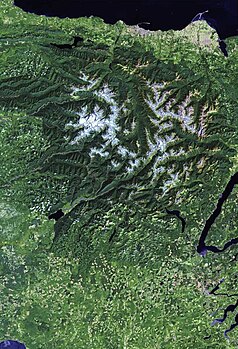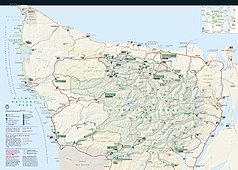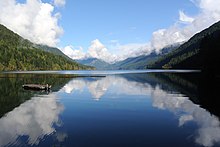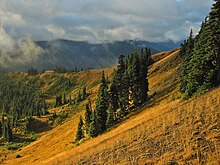Olympic National Park
| Olympic National Park | ||
|---|---|---|
| Satellite image of Olympic National Park | ||
|
|
||
| Location: | Washington , United States | |
| Next city: | Seattle | |
| Surface: | 3,733.83 km² | |
| Founding: | June 29, 1938 | |
| Visitors: | 3,104,455 (2018) | |
| Address: | Olympic National Park | |
| Olympic National Park map | ||
| Mount Olympus | ||
| Olympic National Park | |
|---|---|
|
UNESCO world heritage |
|
| National territory: |
|
| Type: | nature |
| Criteria : | (vii) (ix) |
| Reference No .: | 151 |
| UNESCO region : | Europe and North America |
| History of enrollment | |
| Enrollment: | 1981 ( session 5 ) |
The Olympic National Park (English Olympic National Park ) was founded in 1938 and is located in the western part of the US state Washington on the Olympic Peninsula . Since 1976, the National Park is also known as Biosphere Reserve of UNESCO reported. In 1981 UNESCO declared it a World Heritage Site . Since the national park is located on a remote peninsula, some animal and plant species have developed here that can only be found here in the park ( endemic species ). For this reason, the park is a popular research area for biologists and zoologists .
The national park consists of two separate parts. The coastline is very rugged and often shrouded in fog. Inland, the forest connects directly to the beaches, which often leads to fallen tree trunks lying across the beach. The core area of the park is the mountainous region around the Olympic Mountains , which is covered by many ancient glaciers . To the west of it are temperate rainforest up to the park boundary , here (apart from Alaska and Hawaii ) lies the wettest point in the USA.
history
In the area of the park, individual finds from the Paleo-Indian era about 12,000 years Before Present were made. Only the culture of the Makah is really tangible in the region , which has hardly changed from around the turn of the ages until contact with the Europeans.
Olympic National Park is named after Mount Olympus , which was named in 1788 by Captain John Meares as a worthy residence of the gods. When the forest on the Olympic Peninsula declined in the late 19th century due to logging, President Cleveland declared most of the forests to be Olympic Forest Reserve in 1897 . This protective measure regulated the logging, but not the hunt for the elk . By 1900 their numbers had dropped to less than 20,000 animals. For this reason, President Theodore Roosevelt designated part of the Forest Reserve as Mount Olympus National Monument in 1909 to protect the elk population. The withdrawal of such large areas of forest for forestry was controversial, and the area of the reserve was halved within a year, so that much of the lower-lying areas of the Olympic Peninsula could be cleared. To protect the fantastic rainforests from deforestation, Stephen Mather , Director of National Park Services, and his successor Horace Albright waged a 23-year battle to establish a national park on the Olympic Peninsula. After visiting the area, President Franklin Roosevelt pledged his support and signed the Olympic National Park Act in 1938.
In 1953 the national park was expanded by a strip along the Pacific coast.
In 1988 the US Congress put 3547 square kilometers, i.e. around 95% of the park area, under additional protection as a wilderness area . This also includes 77 kilometers of coastline on the Pacific as the Wilderness Coast . The resulting wilderness is the largest of its kind in Washington State.
The national park is also partially surrounded by the 2564 square kilometer Olympic National Forest , which was formed in 1907 from the part of the Olympic Forest Reserve that does not belong to the Mount Olympus National Monument. In 1984 five Wilderness Aera were founded in it, which border the Olympic Wilderness and cover about 15% of the area of the National Forest with 357 km². The Olympic Wilderness borders the Buckhorn Wilderness in the northeast, The Brothers Wilderness in the east, the Mount Skokomish Wilderness in the southeast, the Wonder Mountain Wilderness in the south and the Colonel Bob Wilderness in the east and south .
The scientific and scenic importance of the national park is internationally recognized. In 1976 UNESCO classified the national park as a biosphere reserve, and in 1981 it declared it a World Heritage Site.
The Elwha River in the north of the park has been the site of the largest renaturation program in the United States since September 2011. Two dams are to be demolished over a period of three years , as a result of which since 1910 and thus before the park was established, over 70 km of the river have no longer been accessible for natural fish migrations. After restoring the original water regime, around 400,000 salmon of all five species occurring in the area are expected in the long term instead of the current 3000 or so Pacific salmon . In August 2012, only five months after the demolition of the first dam, adult Pacific salmon were seen ascending the river much faster than expected .
activities
The park's main Olympic National Park Visitor Center is located near Port Angeles . From there, a road leads to the subalpine Hurricane Ridge , which is up to 1,585 meters high and has a smaller visitor center and partly paved nature trails and numerous hiking trails. A narrow, unpaved road leads from here to 14 kilometers away, 1965 meter high Obstruction Peak . Other roads in the northern park area lead to Deer Park and into the valleys of Boulder Creek and Sol Duc River , from which numerous, sometimes longer hiking routes start. There is another visitor center in the Hoh Rainforest , here too there are several nature trails, some of which are paved, and numerous hiking trails. In total, almost 1000 kilometers of hiking trails in all parts of the park are available to visitors. There are small primitive campsites and some shelters along the extensive hiking routes. On the Pacific coast of the national park, long beach walks are possible in sandy bays such as La Push , Rialto Beach or Ruby Beach . The water of the Pacific is too cold for bathing, even in summer. The visitor center for the beaches and the western part of the park is in Forks . In the south-western part of the park, unpaved roads lead to Queets , North Fork , Graves Creek , Staircase and Dosewallips , which are starting points for hikes, some of which last several days. Lakes like Lake Crescent and Ozette Lake, as well as the numerous rivers, offer opportunities for fishing or boating. In winter you can ski or snowboard on the Hurrican Ridge. In addition to the primitive campsites along the hiking trails, there are 17 medium-sized to larger campsites in the park that are accessible by vehicles. There are two historic mountain hotels in the park: Lake Crescent Lodge and Kalaloch Lodge .
Flora and fauna
Since the national park is located on a remote peninsula, some animal and plant species have developed here that can only be found here in the park (endemic species). For this reason, the park is a popular research area for biologists and zoologists . The best known of these endemic species is the Roosevelt's elk ( Cervus canadiensis roosvelti ), the largest subspecies of the elk. These can weigh up to 450 kg. The national park was established as a National Monument in 1909 to protect this elk. The smallest mammal species native to the Olympic National Park include various types of red- toothed shrews ( Sorex ), which weigh only a few grams ( S. trowbridgii , S. vagrans and S. monticolus ).
Coastline
Mild temperatures and abundant rain make a dense forest grow on the coast of the Olympic Peninsula. Head-high bushes crowd under the tops of the Sitka spruce , the West American hemlock and the giant trees of life . Ferns and mosses form a spongy carpet. In some areas, the forest makes way for the humid prairies near the coast. There, acid-loving plants such as marsh life bearberry , crowberry , Poleiblättrige laurel , Engblättriger wild rosemary , sundew and sphagnum mosses .
On the beaches, the dense forest extends to the ocean. Due to the prevailing westerly winds, there are often huge trees or branches as driftwood on the leeward side . On the tree tops often sit bald eagle and osprey . Jumbled driftwood lies on the beach, which was washed up here over the meandering rivers from the forest.
With a little luck, you can see the sea otters and the seal , which live exclusively in the sea, on the rugged coast of the Olympic National Park . The sea otters were extinct off the coast of Washington in the early 20th century . In 1969 and 1970 reintroduction programs began, so that the number of sea otters is estimated at around 800 animals again today. From March to May, gray whales pass the coast of the national park on their way south. On the coast you can see a number of loons and several representatives of the alkenbird family , including the extremely endangered Marmelalk , which breeds as a sea bird up to 60 km inland.
The northern pelican species of North America, the rhinoceros pelican , is more common here than its relative in the south, the brown pelican . Three species of cormorant can also be found on the coast, the ear shag , the brush shag and the guinea pig .
Mountain region
The subalpine mountain region is reached at around 1,200 meters. On the west side of the park next to the prevailing Western American Hemlock mainly purple fir trees in front. On the drier east side, purple firs can only be found on the north-facing slopes, while Douglas firs and West American hemlocks dominate the south-facing slopes . Forest fires play an active role and create a mosaic of forest of different ages.
In the mountains, the tree line is between 1,500 and 1,800 meters. The alpine zone extends over this. A number of wildflowers grow here, such as B. Campanula piperi , a bluebell species native to the Olympic mountains only . Above this you can find various grasses and sedge.
Here are the golden eagle , lark , raven and also native only in the mountains of Olympic Olympic Chipmunk ( Tamias amoenus caurinus ), a Streifenhörnchenart , as well as the Olympic marmot at home. The gray jay , a close relative of the bad luck jay living in Scandinavia , can often be found in the subalpine coniferous forest , as is the blue jay .
Rainforest
The lush forests in the valleys of the Quinault , Queets , Hoh and Bogachiel Rivers are typical examples of the rustic temperate rainforest. This stretches from southern Oregon to Southeast Alaska . However, little of it is preserved outside of the protected areas. Here, up to 4,000 mm of precipitation fall annually, at a moderate temperature, which even in summer does not exceed 27 degrees Celsius. Here epiphytes , mosses , ferns and lichens grow on the tree trunks and branches, which give the forest a jungle-like appearance.
The tall, old trees are mostly Sitka spruce and Western hemlock . Many of them are over 100 years old and can be up to 80 meters high and up to 20 meters in circumference. Because of the densely forested ground, many sprouts grow on fallen trees. If these rot over time, the stilt-like roots remain. This process can take centuries and is an important habitat for mosses, fungi , small mammals, amphibians and insects .
The Roosevelt elk inhabit the rainforest of the national park. In addition to the elk, the much smaller mule deer also occur in the park . Of the predators , the puma , bobcat , black bear and coyote are represented here. The wolf , which was once also native , has been considered extinct since the 1920s. The fishing marten was also considered to be extinct or almost extinct in the Olympic National Park . Due to heavy overhunting and loss of natural habitat, the fishing marten became a highly endangered species. The marten, about the size of a house cat, and thus the largest representative of its genus, was released back to its original home between January 2008 and February 2010. Since 2007, a wolf reintroduction program has been discussed after the great successes in Yellowstone National Park .
There are around 300 different bird species in the Olympic National Park. One of the best known is the northern spotted owl ( Strix occidentalis caurina ), a subspecies of the spotted owl . Since it places high demands on its habitat and prefers the old forests, which have become rare, it has become a kind of landmark of the Olympic National Park. In addition, you can meet her side also on a number of owls: western screech owl , great horned owl , snowy owl , Gnome pygmy owl , burrowing owl , Barred Owl , Saw Whet Owl and the Barn Owl , Long-eared and short-eared owl .
Of the 23 different North American woodpecker species, seven are found in the national park. Quite often you can Downy Woodpecker , Hairy Woodpecker , Flicker , red-breasted sapsucker and the largest North American woodpecker, the relatives of our black woodpecker , the Pileated Woodpecker observed. On the other hand, blood- faced woodpecker , spruce woodpecker , black -backed woodpecker and red-naped sap-lover are less common .
The family heron is represented by five species in the Olympic National Park: The all over North America encountered Great Blue Heron , which not only with our gray heron is closely related, but this looks very similar, the only occurring in America Green Heron , the North American bittern , which is in turn a close relative of our bittern and the two species of egret and cattle egret, which also occur in Europe .
The duck bird family is represented with over 30 species in this national park. The largest swan species, the trumpeter swan, occurs here as well as the somewhat smaller dwarf swan . Both types of swan occur mainly in the northern part of the continent and, apart from their size, only differ optically from each other in that the dwarf swan has a small yellow spot in front of the eye. Otherwise, both have a black beak and white plumage.
The grebes found only in America can be found there on lakes and rivers. There you can also meet the ear grebes , red-necked grebes and black-necked grebes , which are also native to Europe .
literature
- Tim McNulty: Olympic National Park: A Natural History. 4th edition. University of Washington Press, Seattle 2018, ISBN 0-295-74327-1 .
- Carsten Lien: Olympic Battleground: The Power Politics of Timber Preservation . Sierra Club Books, San Francisco 1991
- Carsten Lien: Exploring the Olympic Mountains: Accounts of the Earliest Expeditions 1878-1890 . The Mountaineers Books, Seattle 2001
Web links
- National Park Service: Olympic National Park (official site; English)
- US National Parks Net: Olympic National Park (English)
- Entry on the UNESCO World Heritage Center website ( English and French ).
- UNESCO MAB Biosphere Reserves
Individual evidence
- ↑ Wilderness.net: Olympic Wilderness. Retrieved April 14, 2011 .
- ↑ National Park Service: Olympic National Park - Elwha River Restoration
- ↑ National Park Service: Olympic National Park - Return of the Kings ', press release August 20, 2012










